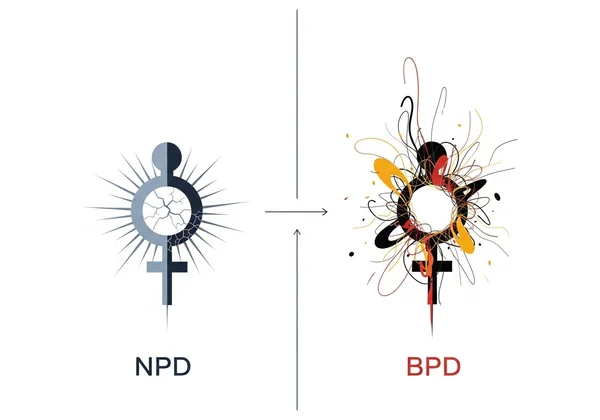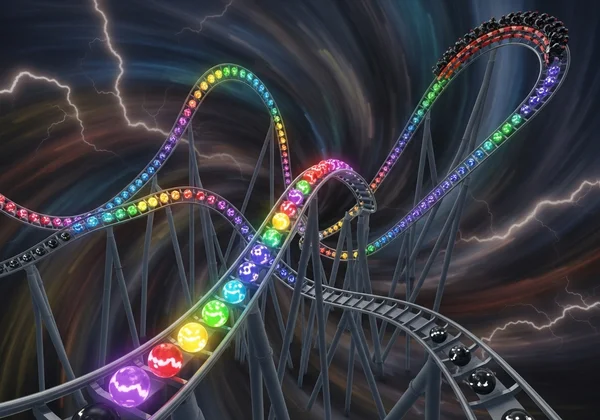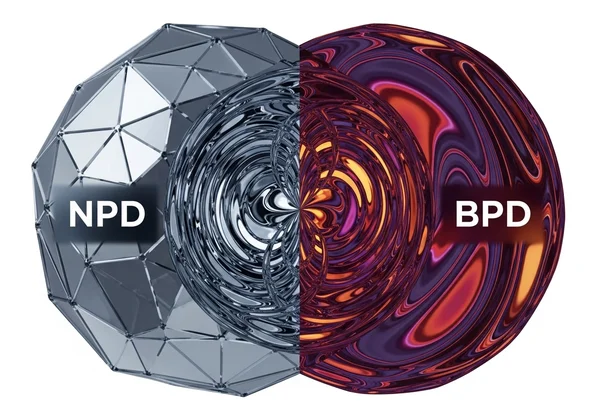NPD vs. BPD: Clear Differences & Overlaps Explained
Are you trying to make sense of intense emotional patterns in yourself or someone you know? The journey to understanding personality can be confusing, especially when faced with the overlapping traits of Narcissistic Personality Disorder (NPD) and Borderline Personality Disorder (BPD). Many find themselves asking, "How do I know if I have NPD or BPD?", as both can lead to volatile relationships and significant distress. Let's untangle this confusion together. This guide offers a clear comparison of npd vs bpd to help you find the clarity you're seeking.
While reading, remember that this information is for educational purposes. True understanding often begins with a single step of self-reflection. If you are questioning your own traits, a screening tool can be a valuable starting point. You can begin your journey at our confidential online test.

Unpacking Narcissistic Personality Disorder (NPD) Traits
At its core, Narcissistic Personality Disorder is defined by a pervasive pattern of grandiosity, a constant need for admiration, and a profound lack of empathy. While pop psychology often paints a picture of simple arrogance, the reality is far more complex. This disorder is rooted in a fragile sense of self that must be protected at all costs. An npd test often explores these underlying patterns.
The Grandiose Facade: Core Characteristics of NPD
The most visible aspect of NPD is the grandiose facade. This isn't just high self-esteem; it's an inflated and unrealistic sense of self-importance. Individuals with NPD traits genuinely believe they are superior, special, or unique and expect others to recognize them as such. This belief system manifests in several ways: fantasies of unlimited success and power, an expectation of special treatment, and a tendency to exaggerate achievements and talents. They seek out admiration as validation of this self-perception, creating a world where their superiority is constantly affirmed.

Internal World of a Narcissist: Fears and Motivations
Beneath the polished exterior lies deep-seated insecurity. The primary motivation for someone with NPD is the preservation of their grandiose self-image and the avoidance of "narcissistic injury"—a perceived threat to their sense of superiority. Their greatest fears and motivations revolve around being exposed as ordinary, flawed, or inferior. This fear drives the constant need for admiration, the exploitation of others to achieve their goals, and the rage that often erupts in response to criticism or perceived slights.
Delving into Borderline Personality Disorder (BPD) Traits
While NPD is built around a stable (though inflated) sense of self, Borderline Personality Disorder is characterized by profound instability. This instability affects emotions, relationships, self-image, and behavior. The world of someone with BPD is often experienced in black-and-white extremes, swinging rapidly between idealization and devaluation of both themselves and others. The borderline personality disorder traits create a life of intense emotional turbulence.
Emotional Rollercoaster: Key Manifestations of BPD
The defining feature of BPD is severe emotional dysregulation, often described as an emotional rollercoaster. Emotions are felt with overwhelming intensity and can shift in an instant. A minor event that others might brush off can trigger profound despair, rage, or anxiety. This emotional volatility is often accompanied by impulsive behaviors, such as reckless spending, risky sexual encounters, or substance abuse, as a way to cope with the overwhelming feelings. This is a key area to differentiate npd bpd.

Underlying Vulnerabilities: Fears and Core Wounds in BPD
The central driving force in BPD is an intense fear of abandonment. The core wounds in BPD often stem from early experiences of neglect or invalidation, leading to a chronic feeling of emptiness and an unstable sense of identity. An individual with BPD may frantically try to avoid real or imagined abandonment, even if it means sacrificing their own needs. Their relationships are often a desperate search for the security and validation they lack internally, making them incredibly vulnerable to perceived rejection.
NPD vs. BPD: Key Differences at a Glance
Understanding the core distinctions between these two disorders is crucial. While both can result in difficult interpersonal dynamics, their internal worlds and motivations are fundamentally different. Exploring these differences can provide much-needed clarity. If you're concerned about narcissistic traits, you can take our free test for initial insights.
Core Motivations Behind the Behavior
The core motivations are perhaps the clearest dividing line. A person with NPD is driven by a need to protect their ego and uphold their sense of superiority. Their actions are designed to elicit admiration. In contrast, a person with BPD is driven by a desperate fear of abandonment and emotional emptiness. Their actions, even when they seem manipulative, are often frantic attempts to feel safe and connected.
Nature of Empathy and Interpersonal Relationships
Empathy is another critical differentiator. Individuals with NPD fundamentally lack cognitive and emotional empathy; they are unable or unwilling to recognize and identify with the feelings and needs of others. Their interpersonal relationships are transactional, valued for what they provide in terms of status or admiration. Conversely, individuals with BPD can often be hyper-empathetic, feeling the emotions of others so intensely that it becomes overwhelming. However, their own emotional pain can override this empathy, leading to reactive and self-focused behavior.
Response to Abandonment and Rejection
Both personalities react poorly to perceived rejection, but for different reasons. The response to abandonment for someone with NPD is narcissistic rage. Rejection is an intolerable insult to their superiority, and they lash out to punish the offender and restore their wounded pride. For someone with BPD, abandonment triggers primal panic and terror. Their response is one of despair, frantic attempts to reconnect, or self-destructive behaviors born from the belief that they are fundamentally unworthy of love.
Self-Perception and Identity Stability
Here, the two disorders are polar opposites. Identity stability in NPD is rigid and inflated. They know exactly who they are: someone superior. Any information to the contrary is violently rejected. In BPD, there is a profound identity disturbance. They may feel like a chameleon, constantly shifting their sense of self, values, and goals based on who they are with. This chronic emptiness and lack of a stable core self is a hallmark of the disorder. A desire to explore your traits can be a healthy first step toward self-understanding.
Recognizing Overlaps: Where NPD and BPD Can Seem Similar
The confusion between narcissistic vs borderline is understandable, as certain behaviors overlap significantly on the surface. Both can exhibit anger, manipulate others, and have chaotic relationships. The key is to always look at the underlying motivation behind the behavior.

Intense and Volatile Relationships
Both conditions are associated with intense relationships that are often unstable. The NPD cycle involves idealizing a partner who provides admiration, followed by devaluing and discarding them when they no longer serve that purpose or "see through the facade." The BPD cycle is also one of idealization and devaluation, but it's driven by the fear of abandonment—they may "push away" a partner to test their loyalty or preemptively reject them before they can be rejected themselves.
Difficulty with Emotional Regulation
A shared difficulty with emotional regulation is a major source of confusion. Both can display intense anger. However, narcissistic rage is a cold, calculated fury aimed at destroying a threat to the ego. BPD rage is a "hot," overwhelming emotional storm that feels out of control and is often followed by intense shame and guilt once it subsides.
Sensitivity to Criticism and Perceived Slights
Finally, both demonstrate an extreme sensitivity to criticism. For the person with NPD, criticism is a direct attack on their core belief of perfection. For the person with BPD, criticism confirms their deepest fear: that they are flawed, worthless, and will ultimately be abandoned. One reacts to protect their ego, the other to protect themselves from overwhelming emotional pain.
Gaining Clarity: Your Next Steps in Understanding Personality Disorders
Distinguishing between NPD and BPD requires looking beyond surface behaviors to understand the deep-seated motivations and fears driving them. NPD is rooted in maintaining a grandiose self, while BPD is rooted in avoiding abandonment. While this article aims to guide you, remember it's not a substitute for a professional diagnosis.
If you recognize narcissistic patterns in yourself and wish to explore them further in a safe and private way, taking a scientifically-backed screening tool is a proactive first step. Our test is designed to provide preliminary insights based on DSM-5TR criteria. Start the NPD test to gain clarity on your journey of self-discovery.
Frequently Asked Questions About NPD and BPD
How do I know if I have NPD or BPD?
The only way to know for sure is through a comprehensive evaluation by a qualified mental health professional, such as a psychologist or psychiatrist. Self-diagnosis can be misleading. However, tools like an online npd screening tool can serve as a confidential first step to identify traits that may warrant further professional exploration.
What are the core diagnostic criteria for NPD and BPD?
The DSM-5 outlines specific criteria for each. For NPD, it includes nine traits, such as a grandiose sense of self-importance, a need for excessive admiration, and a lack of empathy. For BPD, criteria include frantic efforts to avoid abandonment, unstable relationships, identity disturbance, and chronic feelings of emptiness.
Can NPD or BPD symptoms be confused with other conditions?
Absolutely. Symptoms can overlap with other conditions like complex PTSD (C-PTSD), other personality disorders, depression, or even ADHD. This is why a professional assessment is critical to differentiate npd bpd and other potential issues accurately.
If I suspect someone has NPD or BPD, what should I do?
You cannot diagnose someone else. The best approach is to focus on your own well-being by setting healthy boundaries. You can encourage them to seek professional help, but you cannot force them. Learning coping strategies for dealing with difficult behaviors is often the most empowering step.
Is there a reliable online test for NPD?
Yes, but it's important to understand their purpose. A reliable online npd test, like the one offered on our site, is a screening instrument, not a diagnostic tool. It is designed to help you identify potential narcissistic traits based on established criteria. It provides a starting point for self-reflection and can help you decide if speaking with a professional is the right next step. You can discover your results confidentially on our homepage.